What is botulinum? toxin?
Botulinum toxin is an injectable muscle relaxant, commonly known by one of its trademarks, BOTOX®.
Botulinum toxin is responsible for causing botulism, the paralyzing and life-threatening foodborne illness. The name botulinum is derived from the Latin word botulus (sausage) because the disease was once believed to originate from sausages. We now know that botulinum toxin is produced by Clostridium botulinum bacteria.
C. botulinum produces eight types of toxins, labeled A through G. Since the 1950s, research has focused on the development of the muscle-relaxing properties of botulinum-A, and more recently botulinum-B, for therapeutic use.
How do botulinum toxins work?
Botulinum-A and botulinum-B block nerve signals in the muscles. To contract, a muscle must receive a signal to peripheral Nerve endings. This signal is the neurotransmitter, acetylcholine, which binds the receptors to the muscle, initiating muscle contraction. Botulinum toxin inhibits the release of acetylcholine and therefore also inhibits muscle contraction.
More specifically, botulinum-A and botulinum-B target a group of proteins called SNARE (soluble NSF binding protein receiver) SNARE's role is to release neurotransmitters of your storage vesicles Helping vesicle the membranes fuse with the cell membrane. Because SNARE is also involved in the release of other neurotransmitters, botulinum toxins have additional effects. For example, by preventing the release of glutamate and substance P, botulinum toxin decreases pain sensation.
Muscle weakness is usually seen within two to four days, and maximum weakness or paralysis It is observed around ten days. The effects of botulinum toxins are not permanent, because those affected nerves new endings sprout. After about three months, a working connection between the nerve and muscle is restored. However, an element of atrophy (muscle wasting) occurs with each injection. This incremental atrophy explains why the interval required for a second treatment may gradually lengthen after repeated injections.
What are the differences between the different types of botulinum-A?
In New Zealand, there are three commercially available brands of botulinum-A:
- Botox® (onabotolinumtoxinA)
- Dysport® (abobotulinumtoxinA)
- Xeomin® (incobotulinumtoxinA).
Each form has a unique molecular structure but shares the same central elements of botulinum-A. Most research for cosmetic uses of botulinum-A has been based on onabotolinumtoxinA.
It is important to note that there is no international standardized unit that can be used to compare or measure the amount of botulinum toxin administered. This means that the effect of a Botox unit is different from a Dysport unit. The approximate conversion factor is 1: 2.5 to 1: 5 between Botox and Dysport; and 1: 1 between Botox and Xeomin.
Myobloc (rimabotulinumtoxinB) is a commercially available brand of botulinum-B. Myobloc is mainly used in other medical specialties outside of dermatology.
Can botulinum-A reverse the effects of aging?
The appearance of aged skin arises from a combination of factors. Ritid (wrinkles) are caused by alterations pigmentation, redundant and sagging skin, and loss of Soft fabric. Rhytids caused by muscle movements are called dynamic rhytids, while those that do not change with muscle movement are called static rhytids.
As an injectable muscle relaxant, botulinum-A is effective in treating dynamic rhytides and is currently FDA approved for the treatment of rhytides that occur on the upper face.
Forehead lines
The horizontal lines across the forehead result from the contraction of the frontal muscle. This is the facial muscle involved when you express concern; hence the name "lines of concern".
Glabella lines
The vertical lines between the eyebrows result from the contraction of the procerus and corrugator supercilii muscles. These are the facial muscles involved in frowning; hence the name "expression lines".
Botulinum toxin effects
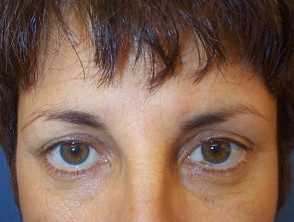
Relaxed subject before botulinum toxin injections
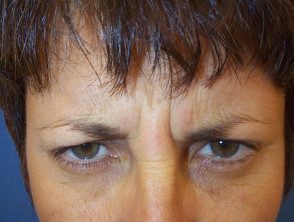
Subject frowning before botulinum toxin injections
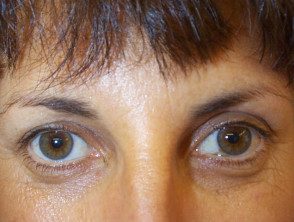
Relaxed subject after botulinum toxin injections
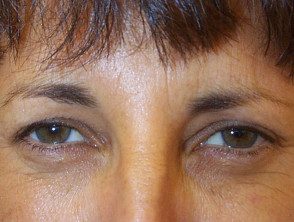
Subject trying to frown after botulinum toxin injections
Crow's feet
The horizontal lines that branch out from the outer corners of the eyes are the result of contraction of the orbicularis oculi muscle. This is the facial muscle involved in facial expression when you smile, and the resulting lines are named after their resemblance to crow's feet.
Botulinum-A is used off-label to treat dynamic rhytids in other parts of the face.
Botulinum toxin injections for crow's feet
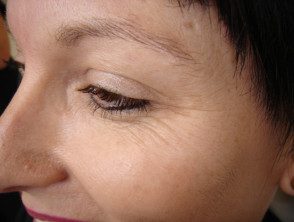
Before injection

After injection
Are there other approved uses for botulinum A?
The other important use of botulinum-A in dermatology is for the treatment of located hyperhidrosis. Hyperhidrosis is a condition of excessive and uncontrollable sweating. Botulinum-A injected into the skin of the armpits and the palms point to eccrine sweat glands to prevent sweating. It is used off label to treat the auriculotemporal syndrome.
Botulinum-A is also approved for the following uses:
- Overactive bladder that causes symptoms of urinary incontinence, urgency and frequency.
- Migraine prevention
- Blepharospasm (abnormal contraction of the eyelid muscles)
- Cervical dystonia (painful spasms of the neck muscles)
- Focal spasticity (localized groups of overactive muscles).
How is botulinum-A given?
Each person's facial muscles are unique; therefore, the botulinum-A injection approach must be individualized. Before any treatment, it is important to evaluate for pre-existing scars or asymmetries, for any evidence of concurrent infectionand for previous cosmetic surgeries, especially on the eyelids.
Botulinum-A is stored in vials, which must be reconstituted by mixing them with sterile ones. saline Water. The mixture should be used within 24 hours to ensure it is not contaminated.
A fine needle (30 gauge) is recommended. For the treatment of dynamic rhytides, small injections (0.1 ml) are made precisely in the muscle responsible for the facial lines. In general, injections can be expected at up to five different sites when receiving treatment for the upper face. A local anesthetic Not generally required. The exception is for the treatment of hyperhidrosis of the hands and feet, where injection into thicker skin can cause a great deal of discomfort.
Rarely, the body's immune system may respond to botulinum A injections by producing antibodies that try to neutralize the effects of the toxin. The main risk factor for developing antibodies is the frequency of injections. Therefore, injections generally should not be given more frequently than once every eight to twelve weeks.
Which are the contraindications to receive botulinum-A injections?
Botulinum-A is contraindicated in individuals with:
- Pre-existing medical conditions that cause muscle weakness, including motor neuron disease (amyotrophic side sclerosis) and myasthenia gravis
- Infection that lines the injection site.
- Previous allergic or hypersensitive reactions to botulinum-A.
Botulinum-A should also be avoided during pregnancy and while breastfeeding.
Certain medications that enhance the effects of botulinum-A should be avoided. These medications include tetracycline antibiotics and aminoglycoside antibiotics
Anticoagulants, such as aspirin, warfarin, and dabigatran, increase the risk of significant bruising at the injection sites.
What are the side effects of botulinum-A injections?
The most common botulinum A side effects are related to the injection, rather than the botulinum toxin itself. These side effects include pain, bruising, swelling, and redness at the injection site.
Bruises from botulinum toxin injections
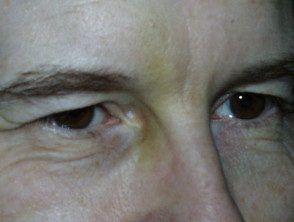
BOTOX® injections
- An uncommon side effect of botulinum-A is involuntary weakness of the surrounding muscles (occurring in less than 10% of treatments). This weakness results from the spread of the toxin from the injection site to adjacent muscle groups
- Eyelids (ptosis), eyebrows, and lips may be affected.
- Weakness can persist for up to 12 weeks.
- Adrenergic eye drops may be prescribed with medications to treat droopy eyelids and eyebrows.
- The muscles of the hand can be unintentionally affected when treated palm hyperhidrosis, resulting in temporary weakness or reduction skill.
- Some people notice a mild headache, usually two to four hours after injection into the forehead muscles, which can be treated with paracetamol (acetaminophen).
Droopy eyelid from botulinum toxin injections

BOTOX® injections
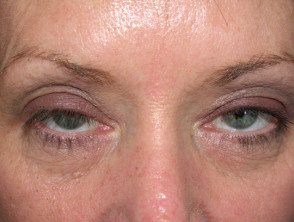
BOTOX® injections
What other uses for botulinum-A are currently being studied?
New uses of botulinum-A are being investigated in dermatology.
Keloids and hypertrophic scars
Botulinum-A injected to paralyze the muscles underlying a healing wound can reduce wound tension on keloids and hypertrophic scarring, which is an important determinant of cosmetic outcome. Botulinum-A can also block nerve signals to help modulate the pain, redness, and itching associated with keloid scars.
Facial erythema and blush
Mixed results have been obtained in studies using botulinum-A to reduce facial redness associated with menopause and rosacea.
Oily skin
Botulinum-A can reduce tallow production in the facial region, due to its effects on the arrector pili muscles.
Postherpetic neuralgia
Postherpetic neuralgia is a common complication of herpes zoster. It is continuous pain after resolution of the eruption. Botulinum-A has been shown to significantly reduce this residual pain by modulating nerve signals.
Raynaud's phenomenon
Botulinum-A injections into the neurovascular bundles in the hands have been reported to reduce pain in Raynaud's phenomenon, which is associated with excess blood vessel constriction when exposed to cold.
Conditions that affect skin folds.
Botulinum-A has also shown promise in improving outcomes for dermatological conditions that affect skin folds, likely by modifying the moist environment to reduce maceration and infection. These conditions include hydradenitis suppurativa, benign family pemphigus, y flexural psoriasis.

